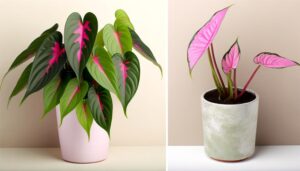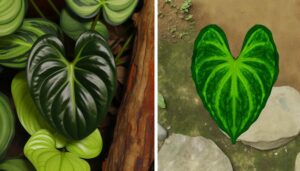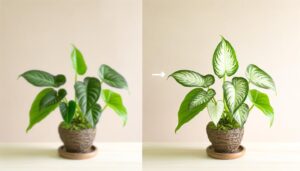Philodendron Plowmanii Vs Gloriosum: Key Differences
Philodendron Plowmanii and Philodendron Gloriosum are distinguished by their unique leaf morphologies and growth habits. Plowmanii features heart-shaped, deeply textured leaves with pronounced veining, while Gloriosum’s foliage is ovate and velvety due to trichomes.
Plowmanii exhibits a trailing growth pattern, whereas Gloriosum grows prostrate with spreading rhizomes. Both prefer bright, indirect light and well-draining soil but have nuanced humidity and moisture needs, Gloriosum being more humidity-tolerant.
Fertilization and propagation techniques involve high-nitrogen fertilizers and methods like root division and air layering. To explore further, the subtle differences in care and maintenance are essential.
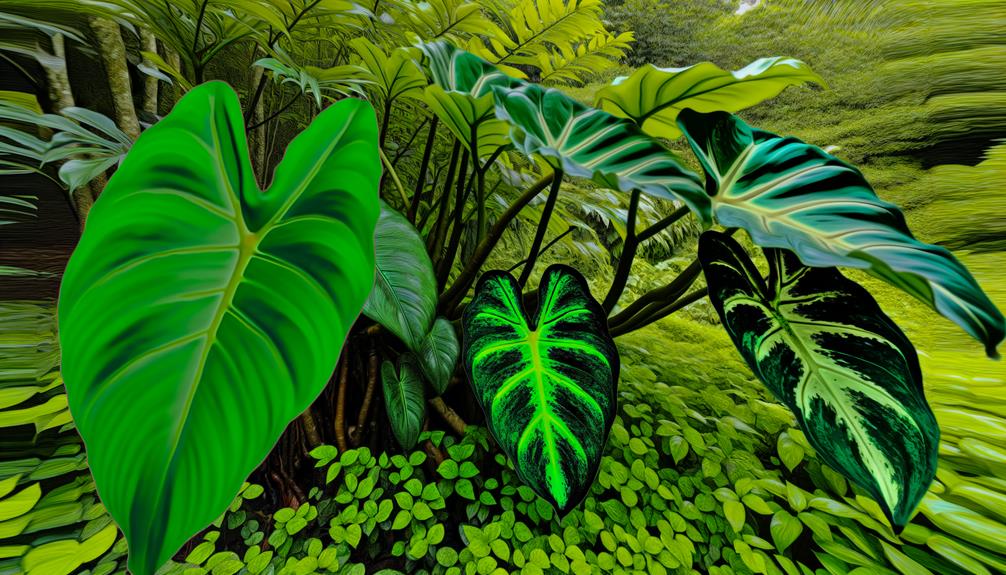
Key Takeaways
- Philodendron Plowmanii has heart-shaped, deeply textured leaves, while Gloriosum features velvety, smooth, ovate foliage.
- Plowmanii grows with a trailing habit and elongated internodes, whereas Gloriosum spreads with a compact, ground-hugging morphology.
- Both species thrive in bright, indirect light, but Gloriosum can tolerate slightly lower light conditions.
- Consistent moisture is essential for both, with higher humidity levels being particularly beneficial for Gloriosum.
- Both plants require well-draining, organic-rich soil and benefit from monthly fertilization during the growth season.
Philodendron Plowmanii vs Gloriosum: Differences in Appearance and Care
| Aspect | Philodendron Plowmanii | Philodendron Gloriosum |
|---|---|---|
| Leaf Shape | Heart-shaped with prominent ripples and texture. | Large, velvety heart-shaped leaves with pronounced white veins. |
| Leaf Texture | Thicker, almost leathery leaves with a ruffled appearance. | Soft, velvety texture with smooth edges. |
| Growth Habit | Creeping growth pattern, often more compact. | Creeping, spreading growth, requiring more horizontal space. |
| Stem Color | Can have reddish tones in the stems and petioles. | Typically green or slightly pink stems. |
| Light Requirement | Thrives in bright, indirect light but can tolerate medium light. | Requires bright, indirect light for best growth. |
| Watering Needs | Prefers consistently moist but well-draining soil. | Similar watering needs but more sensitive to overwatering. |
| Rarity | Less common in collections, more sought after by collectors. | More widely available but still a prized plant for enthusiasts. |
Origins and History

The origins and history of Philodendron plowmanii and Philodendron gloriosum are rooted in the diverse and biologically rich ecosystems of South America. Both species were first described in the late 20th century. Philodendron plowmanii was named in honor of botanist Timothy Plowman, renowned for his extensive research on the flora of the Amazon Basin.
On the other hand, Philodendron gloriosum, celebrated for its velvety foliage, was meticulously documented by botanists focusing on Colombian and Venezuelan rainforests. These species thrive in humid, tropical environments, often found in understory habitats where they play essential roles in local biodiversity.
Both taxa have since become pivotal in horticultural studies due to their distinct morphological and ecological characteristics.
Leaf Shape and Texture
Philodendron plowmanii exhibits heart-shaped leaves with a prominent, deeply textured surface, while Philodendron gloriosum features a velvety, matte finish on its ovate foliage.
The plowmanii’s leaves are characterized by pronounced veining and a corrugated texture, which enhances their aesthetic appeal and tactile interest. The surface texture of the plowmanii leaves often appears almost quilted, with each vein creating a distinct ridge.
Conversely, Philodendron gloriosum’s leaves are more uniformly smooth, with a soft, velvety texture that is due to the presence of minute trichomes. This subtle fuzziness gives gloriosum a luxurious appearance and a tactile softness. Additionally, the gloriosum’s veins are less raised but still prominent, contributing to its distinctive leaf pattern.
Growth Patterns
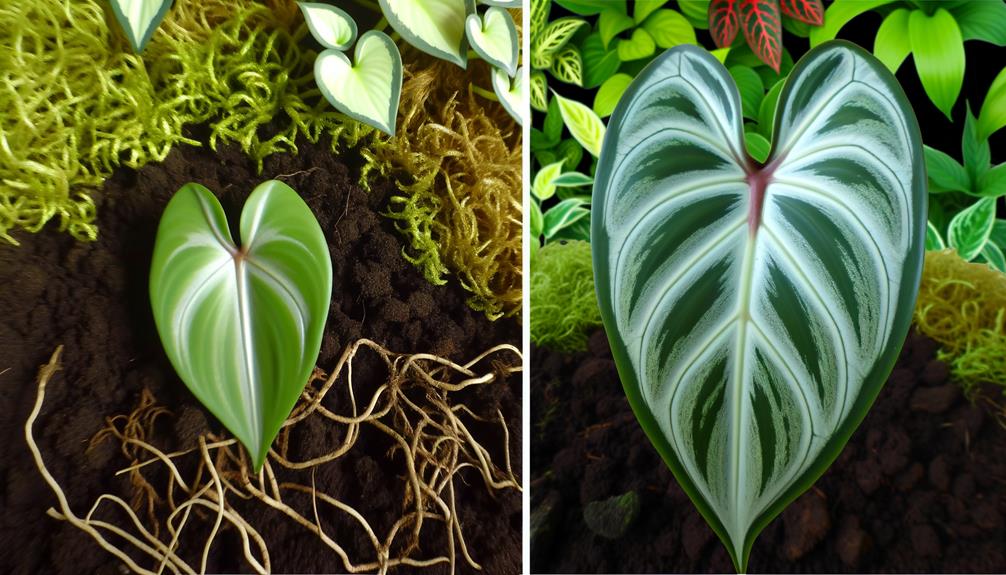
Examining their growth patterns, plowmanii exhibits a more trailing or creeping habit, whereas gloriosum typically presents a prostrate growth form with its rhizomes spreading horizontally across the substrate.
Plowmanii’s growth is characterized by elongated internodes, allowing it to traverse over surfaces or cascade from containers. This species often requires support structures to manage its extended growth, which is facilitated by adventitious roots.
In contrast, gloriosum’s growth is denoted by shorter internodes and a more compact, ground-hugging morphology. Its rhizomatous structure propagates laterally, promoting a sprawling coverage that is ideal for ground cover in its native habitat.
Both species demonstrate distinct growth strategies, which are adaptations to their specific ecological niches.
Light and Water Needs
Understanding the light and water requirements of Plowmanii and Gloriosum is essential for maximizing their growth and ensuring their health in cultivation.
Philodendron Plowmanii thrives in bright, indirect light, replicating its native understory habitat, where direct sunlight is filtered through the canopy. Conversely, Philodendron Gloriosum also prefers bright, indirect light but can tolerate slightly lower light levels. Overexposure to direct sunlight can lead to leaf scorching in both species.
Regarding water needs, both species require consistent moisture, avoiding waterlogged conditions which predispose them to root rot. Plowmanii benefits from a well-draining mix, with watering when the top inch of soil is dry. Gloriosum prefers a similar watering regime but demands slightly higher humidity levels for optimal growth.
Soil and Fertilization
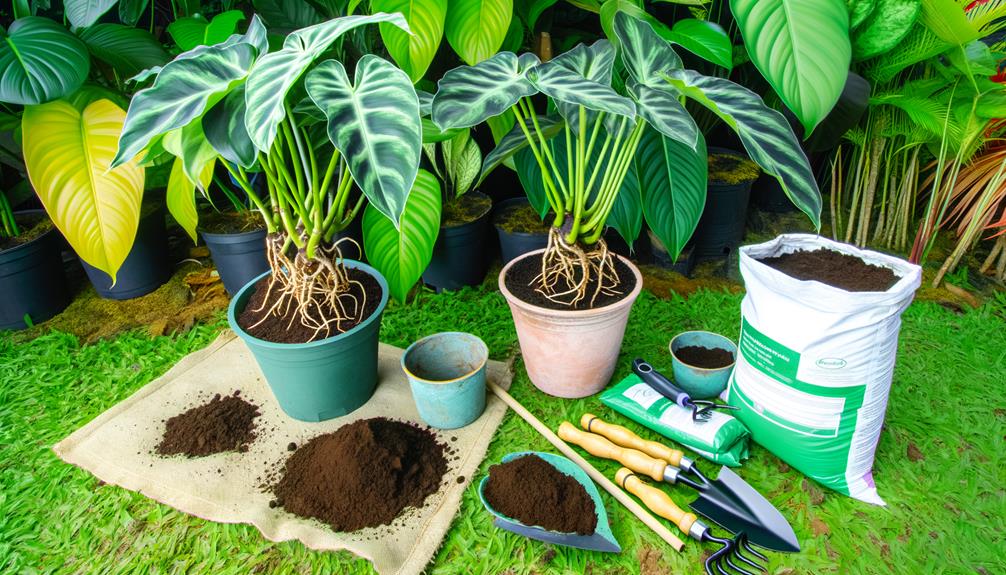
Selecting the appropriate soil composition and fertilization regimen is essential for the best growth and health of both Plowmanii and Gloriosum. These Philodendron species thrive in aerated, well-draining soil rich in organic matter. A mixture of peat, perlite, and orchid bark is ideal. Fertilization should be balanced, with a preference for a slow-release, high-nitrogen fertilizer during the growing season. Here’s a comparative table for clarity:
| Aspect | Plowmanii | Gloriosum |
|---|---|---|
| Soil Type | Peat, perlite, orchid bark | Peat, perlite, orchid bark |
| pH Range | 5.5-6.5 | 5.5-6.5 |
| Fertilizer Type | Slow-release, high-nitrogen | Slow-release, high-nitrogen |
| Feeding Frequency | Monthly during growth season | Monthly during growth season |
| Organic Matter | High | High |
Utilizing the proper soil and fertilization ensures strong foliage and ideal root development.
Common Pests and Diseases
Philodendron Plowmanii and Gloriosum are susceptible to a range of common pests, including spider mites, aphids, and mealybugs, which can cause significant damage to foliage.
Implementing integrated pest management strategies and maintaining ideal humidity levels can effectively mitigate these infestations.
Additionally, disease prevention involves regular inspection for symptoms of fungal and bacterial infections, ensuring proper drainage, and avoiding over-watering.
Common Pests Encountered
Both Philodendron Plowmanii and Gloriosum are vulnerable to a variety of common pests, including spider mites, aphids, and mealybugs, which can compromise their health and vigor.
Spider mites (Tetranychidae family) are tiny arachnids that feed on plant sap, leading to stippling and eventual chlorosis of leaves. Aphids (Aphididae family) are small, soft-bodied insects that excrete honeydew, promoting sooty mold growth and potential viral transmission. Mealybugs (Pseudococcidae family) are identified by their cotton-like wax coating and can cause yellowing and leaf drop due to their sap-sucking behavior.
Infestations often occur in warm, humid environments, requiring regular monitoring and timely intervention to mitigate potential damage and ensure the longevity of these decorative plants.
Disease Prevention Tips
To effectively prevent diseases and mitigate common pest infestations in Philodendron Plowmanii and Gloriosum, rigorous adherence to integrated pest management (IPM) principles is crucial.
Start by employing regular monitoring for early detection of pests such as spider mites, aphids, and mealybugs.
Implement cultural controls, including maintaining ideal humidity levels and ensuring proper air circulation to reduce fungal growth.
Biological controls, such as introducing beneficial insects like ladybugs, can provide natural pest suppression.
Chemical controls should be a last resort; use targeted, low-toxicity pesticides to minimize environmental impact.
Regularly sanitize gardening tools and quarantine new plants to prevent pathogen introduction.
Adherence to these IPM strategies will notably reduce the risk of disease and pest proliferation.
Propagation Methods
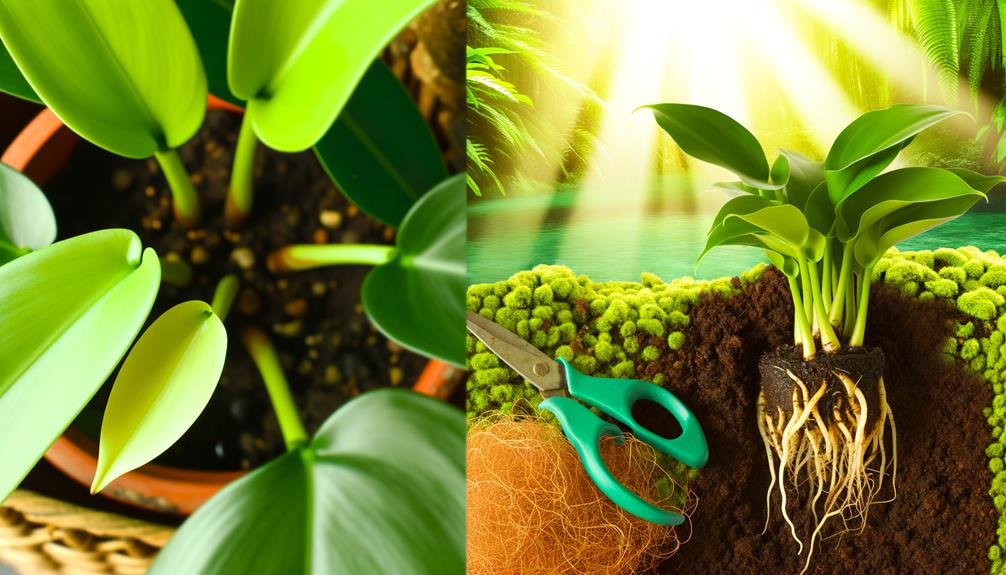
Propagation of Philodendron Plowmanii and Gloriosum can be achieved through several methodologies, each with distinct procedural steps and success rates.
The stem cuttings technique involves excising a segment of the stem, ensuring the presence of at least one node, and promoting root development in a controlled environment.
Alternatively, root division and air layering are advanced methods, with root division involving the separation of the root mass and air layering necessitating the induction of root formation while the segment is still attached to the parent plant.
Stem Cuttings Technique
Utilizing stem cuttings to propagate Philodendron plowmanii and Gloriosum involves selecting a healthy parent plant, guaranteeing that the cutting includes at least one node, and preparing the cutting with appropriate sterilization techniques to prevent pathogen transmission.
Cuttings should ideally be taken with a sterilized blade to reduce infection risks. Following this, dip the cut end into rooting hormone to enhance root development.
Key steps include:
- Node Selection: Ensure each cutting has at least one node, which is essential for root initiation.
- Sterilization: Use 70% isopropyl alcohol to sterilize tools.
- Rooting Medium: Place cuttings in a well-draining medium, such as a mix of perlite and peat.
- Humidity Control: Maintain high humidity around the cutting to promote root formation.
Root Division Process
Root division is a propagation method used for both Philodendron plowmanii and Gloriosum. It involves carefully separating the root ball into smaller sections, each containing a portion of the root system and at least one growth node. This guarantees successful new plant development. The technique requires meticulous handling to avoid damaging the delicate roots and nodes critical for subsequent plant growth. Practitioners should use sterilized cutting tools to ensure a clean division and minimize the risk of infection.
Following division, each section should be planted in a well-draining substrate to ensure sufficient moisture and aeration. Monitoring the divided plants for signs of stress or disease is essential to secure a high propagation success rate and robust growth.
Air Layering Approach
Air layering is a sophisticated propagation technique involving creating a wound on a healthy stem and encasing it in moist sphagnum moss to stimulate root development while still attached to the parent plant. This method is particularly effective for both Philodendron Plowmanii and Gloriosum due to their robust stem structures and high rooting propensity. The process guarantees genetic consistency and enhances survival rates of the new plantlets.
Key steps in air layering include:
- Wounding the Stem: Slice a small section to expose the cambium layer.
- Applying Rooting Hormone: Boosts root initiation at the wound site.
- Enclosing in Moss: Wrap the wound with moist sphagnum moss.
- Securing with Plastic Wrap: Maintains moisture and promotes root growth.
This technique offers a controlled environment for root development, fostering healthier plants.
Conclusion
To sum up, Philodendron plowmanii and Philodendron gloriosum, despite having some similarities, display clear differences in their origins, leaf structure, growth patterns, and maintenance needs. These distinctions call for specific horticultural approaches to promote plant well-being and growth.
To address a potential concern about the absence of visual aids, a comprehensive comparative table or detailed botanical drawings in high resolution could enhance understanding of the subtle variations between these two Philodendron varieties.



